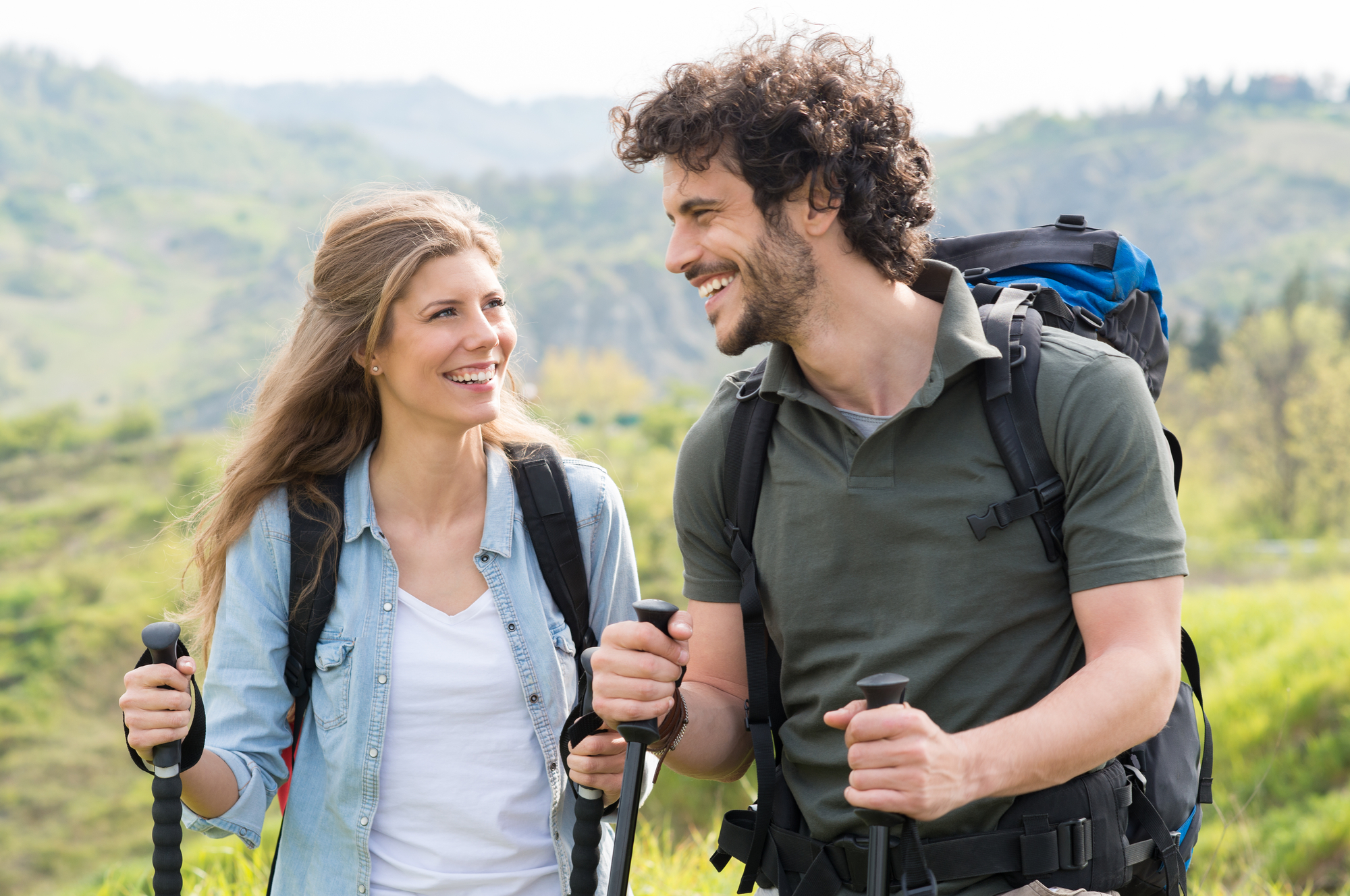
Hiking is one of the most natural things we can do. In fact, our bodies are made to hike. But muscles can get tight when hiking.
Hours on the trail and hundreds of miles in our boots have so many positive effects on our bodies and minds. If you’ve hiked even a little, I’m sure you’ve noticed how much a hike can lift your mood. And you may have seen improved cardiovascular endurance and muscular endurance and reduced body fat.
We also may experience some negative effects. The most common being tight muscles. This can lead to many other problems such as a limited range of motion of joints, cramping, tendinitis, and an overall feeling of soreness. Luckily, there is a way to overcome tight muscles—Stretching.
These 7 best stretches for hikers will enhance your hiking experience.
Six important muscles (plus the IT Band) to stretch.
-
-
- Calf (gastrocnemious and soleus)
- Quads (rectus femoris, vastus medialis, vastus lateralus, and vastus intermedius)
- Hip Flexors (iliopsoas, tensor fasciae latae, pectineus, adductor longus, adductor brevis, and gracious)
- Piriformis
- Illiotibial Band (IT Band)
- Hamstrings (biceps femoris, semitendinosus, and semimembranosus)
- Neck (suboccipital, suprahyoid, infrahydroid, scalenes, sternocleidomastoid and trapezius)
-
Following is a list with videos of the 7 best stretches for hikers.
These stretches are the ones I like and do several times a week. I guarantee that if you’re faithful with these exercises, you will enjoy your hikes even more.
1. The Calf Muscles
Where are they? The calf muscles, the gastrocnemious and the soleus, make up the muscles at the back of your lower leg. They connect to the heel of your foot via the Achilles tendon. They and run up the length of your lower leg, connecting behind your knee.
What do they do? The job of the calf muscles is to extend your ankle. In simple terms, these muscles allow you to point your toes. If you want to work them right now, stand up and raise your heels off the ground. Feel those muscles burning? Those are your calf muscles.
Why are they important to stretch? The main reason to stretch the calves is to prevent injuries. When we walk uphill, the calves stay flexed most of the time. This means that they never have a chance to take a break, tightening with every step you take. Tight calves can cause two major problems, Achilles tendinitis, and plantar fasciitis. Both of these conditions are painful, can take a long time to recover and are usually preventable.
Here is how you stretch your calves:
2. Quads
Where are they? The quadriceps are a group of 4 muscles—rectus femoris, vastus medialis, vastus lateralus, and vastus intermedius. They make up the muscles at the front of the leg. They are best known as the thighs. They run the length of your upper leg from the hip to the knee.
What do they do? The main job of the quadriceps muscles is to extend the knee. Simply put… they straighten your leg. If you are sitting right now, straighten your leg. Feel those muscles? Those are your quads.
Why are they important to stretch? The quads get used every step we take, but walking or hiking uphill drastically increases the load placed on these muscles. The main reason to stretch your quads (besides the fact that it feels good) is to reduce knee pain and help to prevent injuries. Quad tightness can alter the way forces are transferred through the ligaments and tendons in the knee making them more prone to injury.
Here is a great quad stretch:
3. HIP FLEXORS
Where are they? Like your quad muscles, the hip flexors consist of several different muscles: the iliopsoas, tensor fasciae latae, pectineus, adductor longus, adductor brevis, and gracious. They sit at the front of your hip and they run from your trunk to the top of your thigh.
What do they do? As their name suggests, their main job is to flex your hips. What does this mean? Their job is to bring your knee up toward your chest. Stand on one leg and bring the knee of the other leg up. The hip flexor muscles are what raise your knee.
Why are they important to stretch? Like the quads, the hip flexors get used every step we take, but walking or hiking uphill drastically increases the load placed on the hips. When your hip flexors get tight, they can pull your pelvis out of alignment. This can cause an anterior pelvic tilt and an excessive arch in the lower back. Both of these things can cause pain in the lower back.
Here is the best way to stretch the hip flexors:
4. Piriformis
Where is it? The piriformis muscle is a muscle deep in your buttocks. In fact, it lies directly beneath the gluteus maximus muscle.
What does it do? Its job is to externally rotate the hip.
Why is it important to stretch? The reason it is important to stretch this muscle has to due 100% with where it is located. You see, the muscle crosses directly over the sciatic nerve. So, when the muscle gets tight, it can spasm and press on the sciatic nerve causing pain and tingling down the leg. The piriformis gets tight through repetitive movements, such as taking steps while hiking.
Here is the best way to stretch the Piriformis:
5. The Iliotibial Band
Where is it? The Iliotibial Band (better known as the IT band) is a thick, fibrous band of facia that is located on the outside of your thigh muscles. It runs from the very top of your hip, down your upper leg, through the knee, and attaches to the fibia in your lower leg.
What does it do? The gluteal or buttock muscle fibers and the tensor fascia latae (muscles of the hip joint) attach to the IT band, and the band acts to coordinate muscle function and stabilize the knee during walking, hiking, and running.
Why is it important to stretch? When the band becomes irritated, friction may occur with walking, hiking or running, causing lateral knee pain due to inflammation on the side of the knee joint. Pain is most severe with the heel strike and may radiate from the knee up the leg to the hip.
Here is a great way to stretch your IT Band:
6. Hamstrings
Where are they? The muscles of the hamstrings are the biceps femoris, semitendinosus, and semimembranosus. They make up all the muscles on the back of your leg from the hip to the knee.
What do they do? The hamstrings have three jobs
- To flex the knee joint (to bend your leg at the knee)
- To adduct the leg at the hip (to bring your leg out to the side)
- To extend the thigh to the backside of the body (bring your leg behind you at the hip).
Why are they important to stretch? The hamstring muscles are used extensively as you hike. In fact, they play a crucial role in extending the thigh of the leading leg as you step forward. And as the trail gets steeper, the more they will be used.
Here is the best way to stretch your hamstrings:
7. Neck Muscles
The muscles of the neck are the suboccipital, the suprahyoid, the infrahyoid, scalenes sternocleidomastoid and trapezius.
Where are they? The neck muscles sit between your torso and your head. Sorry, I couldn’t resist. The muscle that usually needs the most stretching is the sternocleidomastoid, they sit on both the left and the right side of the neck.
What do they do? The job of the sternocleidomastoid muscles is to rotate the head and to flex the neck.
Why are they important to stretch? Many people who hike will look down toward their feet to watch for rocks, roots, or other obstacles in that might be in their path. Your neck is not used to looking down for such a long period of time and will get tired. Stretching will keep your neck happy even with the extra use.
So, here is the best way to stretch your neck:
There you have it…7 stretches that will help you hike better, faster, with less pain.
Do these stretches every day. Don’t stretch to the point of pain.
You’ll feel the difference, I promise!

